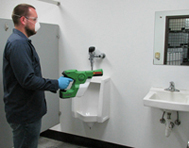Norovirus Outbreaks in Schools – Infection Control
Norovirus is a highly contagious virus that causes the stomach and intestines to become inflamed. This leads to vomiting and diarrhea. Norovirus is often referred to as the stomach flu or food poisoning.
Norovirus is spread by contaminated food and surfaces, and is especially contagious in areas where close contact is common, such as schools, hospitals, cruise ships, and food service establishments. Norovirus outbreaks are more common in these facilities, and it is crucial to know how to prevent and respond to an outbreak, especially when vulnerable populations are involved.
Schools are one particular facility of concern when it comes to Norovirus outbreaks, since children are more vulnerable to illness and are in close contact with one another. Outbreaks can run rampant in schools if not properly handled before and during and outbreak. There are several steps to take to prepare for an outbreak of Norovirus and to respond to an outbreak.
Before an outbreak even begins, it is very important to develop an infection control program. This program will present clear procedures for communication, routine cleaning/disinfecting, intensive cleaning/disinfecting, and hygiene throughout the facility. Having an infection control program in place before an outbreak occurs will help a school be better prepared to handle an outbreak should it occur.
There are 4 major steps to take when responding to Norovirus outbreaks:
Step 1 – Communication
The appropriate people need to be notified of the situation as soon as possible so the proper response can be taken.
The first people to be notified should be the infection control staff, so they can get the ball rolling in containing the outbreak. All the school staff should be notified of the situation so they can take the proper precautions.
External health departments should be notified, as they can provide guidance in how to properly handle the outbreak. Parents of students should also be notified, as they can keep sick students at home rather than at school spreading the illness.
Step 2 – Isolation
Isolation helps limit the contact between sick individuals and those who could contract the illness. Isolation in this case means keeping those who are sick at home, so they aren’t coming in contact with others and spreading the illness.
Those infected with Norovirus should stay home for 72 hours after symptoms go away. Norovirus is still contagious when symptoms aren’t present, so staying home after symptoms subside will ensure that the illness is not spread.
Step 3 – Infection Control
The third and perhaps most important step in response to Norovirus outbreaks is infection control. Infection control procedures should be stepped up in the event of an outbreak.
When school is in session, cleaning and disinfection should focus on high touch surfaces – desks, door knobs, restroom surfaces, etc. These high touch surfaces should be cleaned and disinfected multiple times per day.
When school is not in session, high touch surfaces should still be cleaned and disinfected, but this should be paired with intensive cleaning and disinfecting of all surfaces. This includes floors, playground equipment, etc. This intensive cleaning should continue until the outbreak subsides.
Full surface disinfection can be accomplished by using an electrostatic sprayer designed for use with disinfectant solutions. The E-Sprayer charges disinfectant particles so they are attracted to surfaces like a magnet. The result is a highly uniform coverage of all surfaces, even when the surface is large and complex.
Step 4 – Hand Hygiene
One more thing to consider during Norovirus outbreaks is hand hygiene. Proper hand hygiene techniques should always be followed, but during an outbreak they should be openly promoted and strictly adhered to.
It is also important to note that alcohol-based sanitizers are not effective against Norovirus and are not an appropriate replacement for soap-and-water hand washing.
With proper background knowledge of Norovirus and by following these steps before and during an outbreak, you can much more effectively control an outbreak of Norovirus and, ideally, stop the outbreak before it happens.
For more in-depth information on Norovirus outbreaks in schools, including resources and cleaning/disinfecting checklists, check out our Norovirus Outbreaks – Schools technical bulletin.












